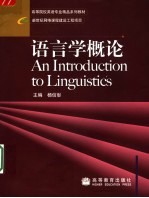

语言学概论PDF电子书下载
- 电子书积分:12 积分如何计算积分?
- 作 者:杨信彰主编;刘承宇,李力编
- 出 版 社:北京:高等教育出版社
- 出版年份:2005
- ISBN:7040159872
- 页数:307 页
Chapter 1 Language and Linguistics 1
1.1 The Nature of Language 1
1.1.1 Language Is Systematic 2
1.1.2 Language Is Symbolic 3
1.1.3 Language Is Arbitrary 6
1.1.4 Language Is Primarily Vocal 7
1.1.5 Language Is Human Specific 10
1.1.6 Language Is Used for Communication 12
1.2 The Functions of Language 14
1.2.1 General Functions of Language 14
1.2.2 Metafunctions of Language 18
1.3 The Origin and Classification of Language 20
1.3.1 The Origin of Language 21
1.3.2 Language Families 24
1.4 What Is Linguistics? 26
1.4.1 Definition of Linguistics 27
1.4.2 Some Important Distinctions in Linguistics 29
1.5 The Scope of Linguistics 35
1.5.1 Use of Linguistics 35
1.5.2 Recent Developments 38
Chapter 2 Phonetics and Phonology 43
2.1 Production of Sounds 43
2.1.1 Scope of Phonetics 43
2.1.2 Articulation of Sounds 45
2.1.3 Characteristics of English Speech Sounds 51
2.1.4 The Transcription of Sounds 54
2.2 Phonemes 56
2.2.1 Definition of Phonemes 56
2.2.2 Minimal Pairs 58
2.2.3 Distinctive Features 60
2.3 Sound Patterns 62
2.3.1 Sequential Constraints 62
2.3.2 Complementary Distribution 64
2.4.1 Syllable 65
2.4 Suprasegmental Features 65
2.4.2 Stress 67
2.4.3 Pitch 69
2.4.4 Intonation and Tone 70
Chapter 3 Morphology and Lexicon 73
3.1 Word and Word Classes 73
3.1.1 Word 74
3.1.2 Word Classes 75
3.2.1 What Is a Morpheme? 81
3.2 Morpheme 81
3.2.2 Types of Morphemes 83
3.3 Inflection and Word-formation 85
3.3.1 Inflection 85
3.3.2 Word-formation 86
3.4 Lexicon 91
3.4.1 Lexeme 91
3.4.2 Features of Lexicon 93
4.1 Sentence Structure 97
Chapter 4 Syntax 97
4.1.1 Constituents 98
4.1.2 Sentence Types 100
4.2 Syntactic Function and Category 104
4.2.1 Syntactic Function 104
4.2.2 Category 108
4.3 Transformational Rules 111
4.3.1 Deep Structure and Surface Structure 111
4.3.2 Sentence Transformations 115
Chapter 5 Semantics 123
5.1 Approaches to Meaning 123
5.1.1 Meaning 124
5.1.2 Three Approaches to Meaning 129
5.2 Semantic Field and Semantic Relations 134
5.2.1 Semantic Field 134
5.2.2 Synonymy and Antonymy 136
5.2.3 Meronymy and Hyponymy 140
5.2.4 Polysemy and Homonymy 142
5.2.5 Intersentential Semantic Relations 146
5.3 Semantic Analysis 151
5.3.1 Componential Analysis 151
5.3.2 Predication Analysis 154
5.3.3 Tautology and Metaphor 157
Chapter 6 Pragmatics and Text Analysis 161
6.1 Speech Act Theory 162
6.1.1 Speech Act 162
6.1.2 Indirect Speech Act 166
6.2 The Cooperative Principle and the Politeness Principle 169
6.2.1 The Cooperative Principle 169
6.2.2 The Politeness Principle 173
6.3 Presupposition and the Structure of Spoken Text 177
6.3.1 Presupposition 177
6.3.2 Exchange and Adjacency Pair 181
6.4 Cohesion 184
6.4.1 Reference 185
6.4.2 Substitution and Ellipsis 188
6.4.3 Conjunction 192
6.4.4 Lexical Cohesion 194
6.5 Thematic Structure and Information Unit 197
6.5.1 Theme and Rheme 197
6.5.2 Given and New 200
7.1 Language Varieties 203
Chapter 7 Language and Social Culture 203
7.1.1 Dialect 204
7.1.2 Register 208
7.1.3 Ethnic Varieties 209
7.2 Language and Culture 211
7.2.1 The Relationship Between Language and Culture 211
7.2.2 The Study of Language and Culture 213
7.3 Language Change 215
7.3.1 Causes of Language Change 215
7.3.2 Lexical Change 218
7.3.3 Sound Change 221
7.3.4 Syntactical Change 222
7.4 Language Planning 223
7.4.1 Standard Language 224
7.4.2 National Language and Official Language 225
Chapter 8 Language Acquisition and Thought 227
8.1 First Language Acquisition 227
8.1.1 Difference Between Acquisition and Foreign Language Learning 227
8.1.2 Development of First Language Acquisition 229
8.2 Second Language Acquisition 233
8.2.1 Major Features of Second Language Acquisition 233
8.2.2 Internal and External Factors 236
8.3 Language and Thought 239
8.3.1 The Relationship Between Language and Thought 239
8.3.2 Psychological Realities 241
9.1.1 An Overview of Language Teaching 247
9.1 Approaches to Language Teaching 247
Chapter 9 Linguistics and Language Teaching 247
9.1.2 The Relation of Linguistics to Language Teaching 249
9.2 Syllabus Design 253
9.2.1 Grammatical Syllabus 254
9.2.2 Situational Syllabus 255
9.2.3 Communicative Syllabus 257
9.3 Language Testing 258
9.3.1 An Overview of Language Testing 258
9.3.2 Basic Considerations 261
9.3.3 Types of Language Tests 262
9.3.4 Language Test Development 265
9.4 Error Analysis 269
9.4.1 Some Basic Concepts 269
9.4.2 Methods of Error Analysis 272
Further Readings 275
References 293
Glossary 299
- 《全国高等中医药行业“十三五”创新教材 中医药学概论》翟华强 2019
- 《程序逻辑及C语言编程》卢卫中,杨丽芳主编 2019
- 《海绵城市概论》刘娜娜,张婧,王雪琴 2017
- 《幼儿园课程资源丛书 幼儿园语言教育资源》周兢编 2015
- 《药学概论》于海平主编 2019
- 《高等学校“十三五”规划教材 C语言程序设计》翟玉峰责任编辑;(中国)李聪,曾志华,江伟 2019
- 《音乐语言的根基》张艺编著 2019
- 《新闻心理学概论 第6版》刘京林 2019
- 《认知语言学视野的抽象方位结构研究》曹爽著 2019
- 《激活语言思维》李蒨,王宏年,汤青编著 2017
- 《全国高等中医药行业“十三五”创新教材 中医药学概论》翟华强 2019
- 《培智学校义务教育实验教科书教师教学用书 生活适应 二年级 上》人民教育出版社,课程教材研究所,特殊教育课程教材研究中心编著 2019
- 《指向核心素养 北京十一学校名师教学设计 英语 七年级 上 配人教版》周志英总主编 2019
- 《习近平总书记教育重要论述讲义》本书编写组 2020
- 《办好人民满意的教育 全国教育满意度调查报告》(中国)中国教育科学研究院 2019
- 《高等数学试题与详解》西安电子科技大学高等数学教学团队 2019
- 《北京生态环境保护》《北京环境保护丛书》编委会编著 2018
- 《教育学考研应试宝典》徐影主编 2019
- 《语文教育教学实践探索》陈德收 2018
- 《家庭音乐素养教育》刘畅 2018
